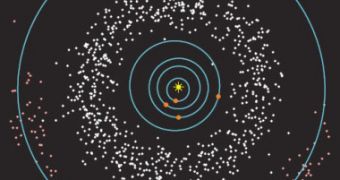It's not often that astronomers find asteroids made out of a single massive piece, but rather containing two or more objects loosely bound together or orbiting each other, tumbling through the immensity of space. The cause to this particularity remained a subject of debate for a long time, although now a new study proposes that energy emitted from the Sun could force the asteroid into a spin which will eventually determine it to split in several pieces, eject material and even create separate satellites.
"So far our results match the properties of binary asteroids quite well," says Kevin Walsh of the Observatoire de la Cote D'Azur, graduate student of the University of Maryland and lead author of the study. Binary asteroids were first found 15 years ago and have puzzled the minds of astronomers ever since, with their weird configuration.
Under the advisory of Derek Richardson and Patrick Michel of the Cassiopee, University of Nice-Sophia Antipolis, Walsh created a computer model showing that up to 15 percent of asteroids orbiting in the vicinity of Earth are binary asteroids. The progenitors of these systems were considered to be collections of multiple rocks held together by gravity, since most of the discovered asteroids appear to be non-solid objects able to reconfigure their shape according to different forces acting on them.
As sunlight hits the irregular surface of the asteroids, they are forced into a spin through the so-called YORP effect, which can also slow down the spin rate of an asteroid during gravitational interactions with other objects. Eventually, in time, as the spin rate increases, the shape of the asteroid tends to become spherical, accumulating slightly more mass in the equatorial region as a result of the centrifugal force acting on it.
In the end, the spin rate may exceed the critical rate at which the gravitational force becomes smaller than the centrifugal force, triggering the ejection of matter through the equatorial regions, forming a binary asteroid system.
"Ours was the first model that could actually simulate an asteroid being spun up to its maximum spin rate by the YORP effects. We made the first step and showed YORP can make systems that look exactly like what we observe," explained Walsh.
The preliminary results of the study were then compared with the observations on a binary asteroid known as KW4. "It's by far the best observation we have of any single asteroid. Globally, observations suggest that nearly all the small near-Earth binary systems are similar to this KW4 system. We recreate its shape pretty closely with a lot of our simulations," he said.
A similar effect can be obtained during collisions with other bodies or during gravitational interactions with much more massive bodies, albeit the YORP effect could be responsible for most of the binary asteroids observed in the solar system.

 14 DAY TRIAL //
14 DAY TRIAL //